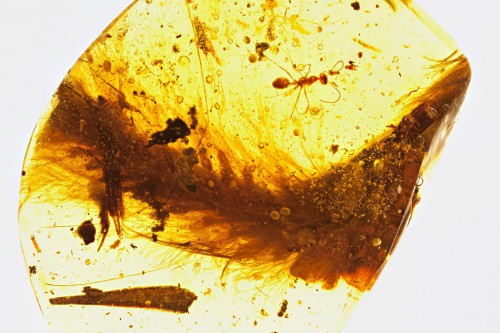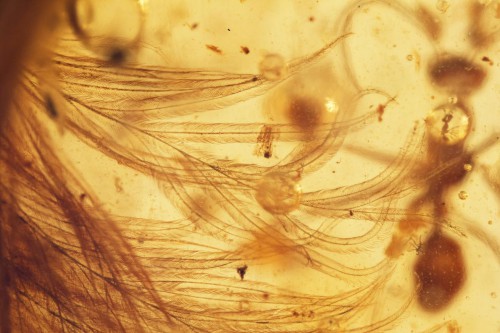A short fragment — 8 vertebrae — of a coelurosaur tail has been found, preserved in amber. It’s almost 100 million years old.
It’s covered with feathers, with countershading from brown on top to white on the bottom.
How can something so expected be so astonishing?




100 Million years of history in one small peace of hardened tree sap. How beautiful it is.
100 million years is approximately the time frame since the Atlantic Ocean opened up, separating Europe and North America. The ocean has been spreading at the same rate that nails grow ever since.
The oldest bones from which we have extracted DNA are 50 000-80 000 years old, which represents the ocean widening the same span as the width of the estuary of a major river, like Elbe, or Mssisippi.
When people ask “why cannot we get dinosaur DNA”? ask them to compare the width of a big river with that of the Atlantic.
Everyone’s just ignoring that astonishing hymenopteran. Tsk.
#whatabouttheinsects
So where’s the rest of the dinosaur…? I want to see just how fluffy and cuddly it is.
Absolutely astonishing discovery. In my life I have seen the perception of dinosaurs change from not too coloured sluggish stupid lizzards to feathered and brightly coloured animals with rich social life. I wonder what else we do not know and will discover.
That they spun webs?
Wow. Just wow.
Oh no! Now they’ll extract its DNA and recreate it, it will escape and breed, and we’ll all be devoured by ravening super-predators ten meters long…
Ah. I misread: ten centimeters long. But still.
Speaking of DNA, that Kirk Douglas must have some super genes!
Encounter with black monolith ???
“Kirk Douglas Turns 100 Today
http://www.huffingtonpost.com/entry/kirk-douglas-best-films_us_58471243e4b016eb81d87d5f
It was discovered at a Chinese flea market.
Myanmar is not in China.
Someone finally found an amber-preserved dino chunk!
…nor was it a “flea market”.
As the link says,
Myanmar, not China. In an amber market, not a flea market.
No one entertaining the possibility it’s a mogwai?
I am absolutely gobsmacked!! This has made my day!!
This is such a wonderful fossil. My first impression on seeing the photo come over my news stream was Grouse, not dinosaur. The preservation is simply marvelous!
That hymenoptera has such long thin legs, reminds me of army ants. I wish I could get a better look at the arachnid (?!) on the right. The orthoptera antennae and leg fragment are cool too, but not all that different from modern species.
———-
Coincidentally I watched a lecture by Jack Horner earlier this week that was mainly on his work in cutting dino bones to establish that the same creatures had juvenile through adult forms. He talked for a bit about the fossil with preserved tissues and the unsuccessful attempts to extract DNA. The images of the skin, and blood vessels he had were amazing science too, but not nearly as evocative as a cute fluffy tail.
Emily Dickenson wrote “Hope is the thing with feathers.”
Woody Allen wrote, in his book Getting Even: “How wrong Emily Dickenson was! The thing with feathers turns out to be my nephew. I must take him to see a specialist.”
@Tethys #16, I’m quite certain that DNA can be retrieved from this sample. Fragmented, cross linked, totally tangled, but some DNA could likely be retrieved.
Even money, with some bacterial DNA from the era to keep it company. :/
But, what wowed me in the morning and this evening, when reviewing the original story’s imagery, that the feathers have the same features that modern feathers do. Hooks on the ends (can’t recall the proper name offhand), to link the feather together, apparently hollow shaft, etc.*
Again, humbled by what could be spelled out with a mere four letters and an embarrassed chuckle over our many letters, which build far, far, far less.
*I don’t subscribe to the dinosaur extinction event being exclusively an impact event and global oven and windstorm. If that supremely heat intensive, high shockwave at a global scale event occurred, frogs would’ve been boiled in their ponds and birds would’ve been plucked, then cooked.
I’m more of continental drift induced oceanic current changes, continents merging after a long separation causing novel disease spread *and* a major impact event creating a challenge that many species could not address and those who could scavenge and do with lower nutritional input survived and thrived.
A Theia impact, yes, something that modest in comparison and what did survive, nope. Most probable, a collection of challenges that could not be overcome.
Sort of like Trump and his cabinet causing the eventual extinction of humanity, if the EU zone also goes equally conservative.
Sorry about the last, it felt like a hairball, but wasn’t.
It may technically be a ‘fossil’, but it sure isn’t a mineralized specimen or a mere impression in rock. That lovely specimen, with its every delicate attribute, looks as fresh as the day it was entombed. [‘Chills rush up the spine’]
@18 wzrd1
It is fascinating, but complete feathers running up to type-5 flight feathers (in the Prum & Brush system) with asymmetry along the vane should be expected in Cretaceous theropod species if Aves really diverged in the Jurassic as is thought.
As for the extinction event debate, I would agree there is certainly more than enough evidence for North American non-Avian dinosaurs to have destabilized in dozens of different ways around the K/T boundary (constant recession and reclamation both in Beringia and the Laurentian inland deformation which could cause predatory species migrations and unchecked disease, the Yucatan impact, climate change due to glacial recession, etc.) You could call these the J. Archibald hypotheses. But as I understand it, the problem is only impact (and Deccan volcanism) work as theories on a global scale, and we lack evidences in the rest of the continents of the kind of periodic isolation attributed to North America. Other than in the cases of certain flighted species who no doubt migrated inter-continentally over the Atlantic, there is no reason to presume a purely floral/faunal-derived extinction event in one continent leads to extinction in all of them.
wrzd1
I am not sure of the exact timeframe, but whether or not there would be DNA is more a function of time. DNA starts to degrade at the moment of death, and even with ideal preservation by the time 20,000 years have passed the DNA is gone. His entire point was that if it was possible to extract DNA from blood in a mosquito in amber, you would get mostly mosquito DNA mixed in with tree DNA and anything else that had gotten stuck in the amber.
It looks a lot like an ant. 99 million years puts it right at the point where the ant lineage is thought to have diverged from the solitary wasps. The oldest ant fossil I know of is only around 93 million. This rock could easily be on the short list of the most important insect fossils out there, and everybody’s too distracted by the silly chordate stuff to pay any attention at all. :)
I don’t comment here often and don’t want to risk the filters by including links, but the article is available in the online version of Current Biology and it includes a number of high-res photos. It’s really neat stuff.
I should add that Current Biology isn’t paywalled. The original article is published under a Creative Commons license.
wrpinpnw, you can easily put in up to 5 or six links.
You can use simple copypaste of the url
https://en.wikipedia.org/wiki/Arachnid
or you can embed the url in words using <a href = “https://en.wikipedia.org/wiki/Arachnid”>Wiki on arachnids</a> and get
Wiki on arachnids
OK, cool.
“A Feathered Dinosaur Tail with Primitive Plumage Trapped in Mid-Cretaceous Amber”, Xing et al.
A high-res image that includes both dorsolateral and ventrolateral views of the amber
Thank you so much wrpinpnw! I am geeking out over the face of the ant. It’s an ant!!! An arboreal ant! The thorax is very elongated, no evidence of wings, and one of them appears to have a stinger, but that is an ant face.
Sadly the high res has many white reflections over the possible arachnid so I cant see much beyond lots of legs on an arachnid shaped critter. It appears to be on top of a beetle carapace. Are those pincers visible underneath it?
There is also some sort of midge over by the cricket, a striped, poorly preserved abdomen, and a critter that looks somewhat like a silverfish above the ‘ants’.
Yeah, there’s a lot going on. In addition to the ones you mention, there are at least two flies and a number of very small things that I have no hope of recognizing. I’m not sure about the “arachnid” — it’s pretty well obscured, and might be a third Hymenopteran — but the parts beneath it look more like terci than pincers, so maybe an earwig or close relative.
The antennae of the two clearly visible Hymenoptera are more wasplike than antlike, but otherwise they look very much like ants, especially around the “waist” — the petiole looks pretty well defined to me. Unfortunately, the one that’s obviously female has her ventral side facing the edge of the amber, so it would be hard to spot the metapleural gland without excavating.
It seems likely that someone will spring for a high-res scan of the amber. If they do, I hope they spare some bandwidth for the bugs.
I checked a fossil group I frequent to see if anyone else was also excited about the various bugs. No discussion on them at all, but they are calculating how much tree sap you would need to preserve a T-rex. :D
My first impression of arachnid is due to the legs looking curved. On closer inspection I agree, it could be another hymenoptera. Were there jawed earwigs in the Cretaceous? It could also be the predatory larval stage of something like a lacewing or owlfly, which would be a fantastic fossil find in its own right.
correcting myself. Were there earwigs with pincers in the Cretaceous? Not jaws, as the pincers are on the other end of the earwig.
How viscous was that sap?
Did the wee dino lose its tailtip premortem or postmortem?
what species of tree was that amber from?
Is amber from more than one species of tree or just one?
where could look for that information?
uncle frogy
wikipedia article on amber is a good start. Several species of trees make oleo-resin that can eventually become amber. Most of them are conifers.
thanks
I asked before I looked and read the Wikipedia stuff
I like to understand the whole context and appreciated the side discussion of the other things in that amber. things are often shown in isolation as individual specimens for clarity
but nothing exists like that.
uncle frogy
Yeah, the Dermaptera are an old group. There are fossil earwigs (or close relatives, at any rate) with unsegmented terci (“pincers”) going back into the Triassic.